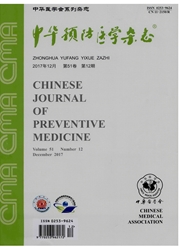

 中文摘要:
中文摘要:
目的了解中国鲍曼不动杆菌多重耐药株的遗传背景,并分析鲍曼不动杆菌的种群结构。方法采用多位点序列分型(MLST)分析了33株来自中国的鲍曼不动杆菌多重耐药株,并汇总MLST数据库中该菌的相关数据,鉴定了序列型与克隆群,分析了各个看家基因是否存在同源重组,计算了总体种群的标准化关联系数(I^sA)、重组与突变比值。针对MLST数据库中所有423株菌的等位基因型图谱,构建了种群系统发育树。结果33株菌中有6个序列型,其中29株属于CC92克隆群。所有7个看家基因中(gltA、gyrB、recA、cpn60、gah8、gpi、,poD),后3个位点发生了统计学意义上的重组。总体种群的重组及突变比值为6.083,I^sA值为0.155。所有纳入分析的423株菌可分为224个序列型,共鉴定出10个克隆群,其中CC92是主导克隆群。423株菌的系统进化树较好地呈现各序列型之间的进化关系,直观地展示了鲍曼不动杆菌的微进化。结论33株鲍曼不动杆菌多重耐药株大多属于CC92克隆群。鲍曼不动杆菌的种群内存在频繁重组,但等位基因型仍保持着连锁不平衡的特征,该菌具有典型的Epidemic种群结构。
 英文摘要:
英文摘要:
Objective To characterize the genetic background of multidrug-resistant Acinetobacter baumanni(A, baumanni) from China, and the population structure of this pathogen. Methods A previously reported MIST scheme was applied to a collection of 33 multidrug-resistant strains of A. baumanni from China, and the data of all the strains in the A. baumanni MIST database were downloaded for the population structure analysis. The sequence types and elonal complexes were identified, the presence or absence of recombination was analyzed for each MLST locus, and the values of I^sA, and recombination/mutation ratio were calculated for the whole strain collection. A phylogenetic tree was constructed using all the allelic profiles in the database. Results A total of six sequence types were identified from the 33 Chinese strains tested, and 29 of these strains belonged to the CC92 clonal complex. Three (gdhB, gpi, and rpoD) of the seven MLST loci ( gltA, gyrB, recA, cpn60, gdhB, gpi, rpoD ) had undergone recombination with statistical evidence. For all allele profiles in the MLST database, the I^sA value was 0. 155 and the recombination/ mutation ratio was 6. 083. Sequence types from each clonal complex were grouped closely in the phylogenetie tree, which gave an overview of the microevolution of this pathogen. Conclusion The spread of multidrug-resistant A. baumanni in China was closely related to the CC92 elonal complex. A. baumanni had an 'epidemic' population structure, i. e. , a superficially clonal structure with high levels of recombination, in which successful epidemic clones arise especially including worldwide dissemination of the CC92 clonal complex to cause a widespread occurrence of multidrug-resistant infections.
 同期刊论文项目
同期刊论文项目
 同项目期刊论文
同项目期刊论文
 期刊信息
期刊信息
